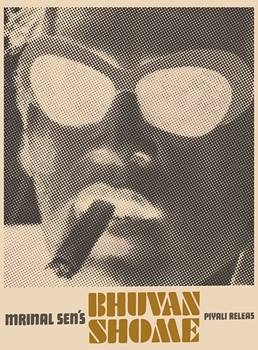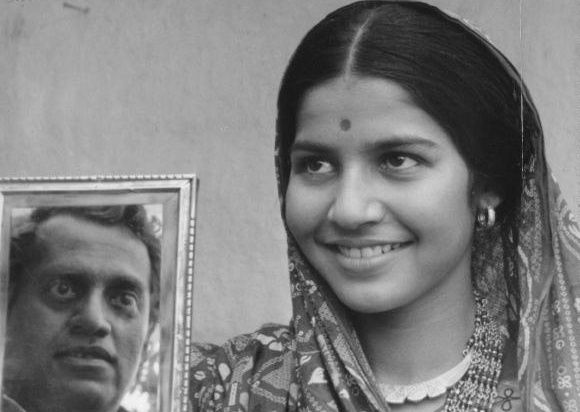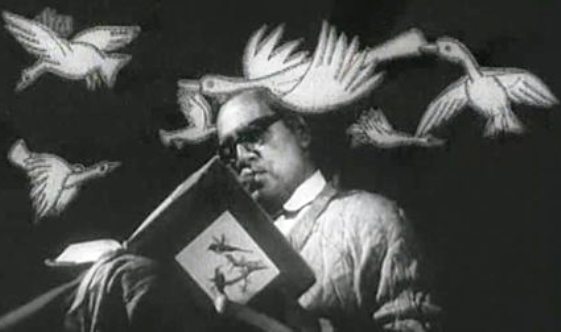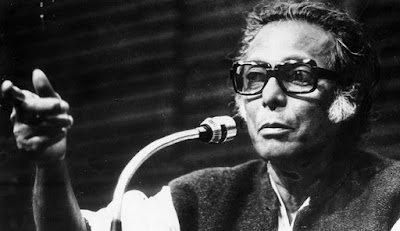By Murtaza Ali Khan (@apotofvestiges)
Featured in IMDb Critic Reviews

Bhuvan Shome (1969) - By Mrinal Sen
Bhuvan
Shome is a 1969 Hindi classic film written and directed by the legendary Indian
filmmaker Mrinal Sen and starring the renowned Bengali actor Utpal Dutt and
Marathi actress Suhasini Mulay (making her film debut) in the pivotal roles. Bhuvan
Shome also marked the debut of the celebrated Indian actor Amitabh Bachchan who
narrates the film in a playfully sardonic voice. Sen’s screenplay is based on a
Bengali story by Banaphool aka Balai Chand Mukhopadhya. Recipient of three
National Awards—Best Feature Film, Best Director, Best Actor—Bhuvan Shome not
only ended Mrinal Sen’s unsuccessful streak as a director but also played a
pivotal role in establishing him as a filmmaker of international repute. One of
the first few films to get funded by the National
Film Development Corporation (NFDC), which was back then known as the Film
Finance Corporation (FFC), Bhuvan Shome is also said to have pioneered the
Indian New Wave.
The
film revolves around a ruthless Bengali bureaucrat, working in the Indian
Railways, named Bhuvan Shome who is greatly feared by his subordinates. A
middle-aged widower, Bhuvan Shome has spent his life trying to be righteous and
has zero tolerance for the corrupt or the incompetent. As informed by the
narrator, once he even went to the extent of firing his own son. He is highly
respected by everyone around him but being a martinet he is forced to live in abject
solitude. One day, bored by his monotonous office routine, he decides to go on
a bird hunting trip to Saurashtra—a flourishing region located on the Arabian
Sea coast of the Indian state of Gujarat. Doomed to live in solitude, Bhuvan
Shome, trapped in an alien land, quickly realizes that he has inadvertently
pushed himself a bit too far out of his comfort zone. The rest of the movie is more
like a journey of self-realization for Bhuvan Shome who gradually learns to
appreciate the importance of human company.
Perhaps, the most striking thing about Bhuvan Shome is that it is minimalistic without being devoid of style. The plot is bereft of any structure and mostly conveys a randomness of thought on the part of the maker. Sen adopts a documentary style to devise the movie’s narrative. For introducing the titular character of Bhuvan Shome, a hardcore Bengali who for the most of his life has lived outside of Bengal, Sen uses a montage including pictures of Vivekanda, Rabindranath Tagore, Satyajit Ray, Ravi Shankar, and public agitation of the communists on the streets of Calcutta (now Kolkata), perhaps in a bid to accentuate upon the peculiarities of Bengal/Bengalis. Another unique aspect of Bhuvan Shome is Sen’s use of animation at different points in the narrative. Apparently, it didn’t go well with Sen’s more accomplished fellow Bengali filmmaker Satyajit Ray who censurably summed up Bhuvan Shome as “Big Bad Bureaucrat Reformed by Rustic Belle”. Although, Satyajit Ray may not have approved Bhuvan Shome at the time, the film’s influence on him is quite evident in Shatranj Ke Khilari (1977), which not only uses animations but also employs Amitabh Bachchan’s playfully sardonic voiceover narration.
There
are several ways to approach Bhuvan Shome. At its most elementary level, it can
be described as a film about a man’s bird hunting adventure on the shores of
Saurashtra. The theme of hunting is often associated with the elite, upper class people trying to overcome their boredom. The bird hunting expedition in Bhuvan Shome harks to Jean Renoir's The Rules of the Game (1939). At another level, the film can be seen as a powerful character study
of a strict bureaucrat who finds it difficult to survive the moment he steps
outside the comforts of his cocooned existence. The film can also be looked
upon as a treatise on human solitude and longing for companionship. Yet another
way to approach the film is a social commentary on the great rural-urban divide
in India. While a powerful bureaucrat like Bhuvan Shome living in the city is
cruel to everyone around him, the people in the village are friendly and helpful
even to the strangers. Bhuvan Shome is also a film about human camaraderie and
trust. How a beautiful village girl named Gauri leaves everything aside to help
a total stranger whom she sees as her guest. How Bhuvan Shome blindly trusts
the young girl during his bird hunting expedition. One is reminded of Akira
Kurosawa’s Oscar-winning masterpiece Dersu
Uzala (1975). Some have even commented on the undercurrent of eroticism
that runs through the movie. While it is quite obvious that Bhuvan Shome grows
fond of the young village girl, there are a few scenes in the movie that obliquely suggest the
possibility of sexual attraction.
Mrinal
Sen’s imaginative direction is brilliantly complemented by K. K. Mahajan’s
breathtaking black & white cinematography which gives the movie its soul. Mahajan
brilliantly captures the vast expanses of Gujarat’s desert land, even reminding
one of the majestic desert scenes from David Lean’s Lawrence of Arabia (1962). The
extreme close-ups reveal a lot about the characters even before we get to hear
them talk. The overhead shots of moving railway tracks, horse/bullock carts are
used to accentuate the toil associated with travel. The editing techniques
employed in the film are quite clever. In addition to a couple of impressive
montage sequences, the movie uses a lot of jump cuts and freeze-frames. There
is a beautiful sequence in Bhuvan Shome which deserves a special mention wherein
Gauri pretends to be on a swing and the camera strategically zooms in and out
on her, imitating the swing action. Vijay Raghav Rao’s musical pieces immensely
add to the experience.
Overall,
Bhuvan Shome is a groundbreaking work of cinema that set the ball rolling for
the Indian New Wave. The film is a testament to Mrinal Sen’s iconoclastic
genius as filmmaker. Here is a piece of cinema that’s free from the conventions
of plot and structure. Unburdened by the onus to provide any definitive endings/solutions
to problems, this brand of cinema endeavors to encourage the viewers to
actively participate in finding the answers to the questions posed by the
filmmaker. Another strong point of Bhuvan Shome is the acting performances of Utpal
Dutt and Suhasini Mulay. Anyone who aspires to become an actor ought to study
Dutt’s performance in the movie very closely. A part as complex as Bhuvan Shome
requires an actor to blend ruthlessness, vulnerability, and tenderness in equal
parts, and, Dutt, of course, is up to the task. His eyes, facial expressions
and body gestures together communicate a lot more than his verbal delivery. A
lesser actor would have made the character of Bhuvan Shome look like some cartoon,
but, Dutt, to his credit, breathes life into it. Suhasini Mulay essays the part
of a rustic belle beautifully and her amiable character serves as the perfect
foil for Dutt’s mean bureaucrat. One can go on and on talking about the different
aspects of Bhuvan Shome. It is a film that can be enjoyed at so many different
levels. The movie’s entertainment quotient is surprisingly quite high. If you
love movies, Bhuvan Shome wouldn’t disappoint you. It is essential viewing
for every student of cinema.
Mrinal Sen, during the course of his illustrious filmmaking career, has been one of the greatest ambassadors of Indian cinema on the global stage. Sen's cinema is primarily known for its artistic depiction of social reality. Without doubt, he is the greatest filmmaker alive and one of the very few filmmakers ever to have won an award or recognition at all the major cinematic forums in the world. Today, at the age of 93, Mrinal Sen continues to be a great source of inspiration for the students of cinema. His formidable body of work today stands tall amongst the greatest oeuvres in world cinema. Mrinal Sen is a living legend and a modern master of cinema. Recipient of civilian honors like Commandeur de Ordre des Arts et des Lettres (conferred by the French President) and Order of Friendship (awarded by the Russian president), Sen is highly deserving of India's highest civilian honor and it is high time he is conferred the Bharat Ratna. Please support our petition filed at change.org with your valuable vote by visiting the following link:
Readers, please feel free to share your views/opinions in the comment box below. As always your feedback is highly appreciated!
References:
Watch Bhuvan Shome (Rajshri's YouTube Channel )
By Murtaza Ali Khan (@apotofvestiges)
Featured in IMDb Critic Reviews
 |
| Bhuvan Shome (1969) - By Mrinal Sen |
Bhuvan
Shome is a 1969 Hindi classic film written and directed by the legendary Indian
filmmaker Mrinal Sen and starring the renowned Bengali actor Utpal Dutt and
Marathi actress Suhasini Mulay (making her film debut) in the pivotal roles. Bhuvan
Shome also marked the debut of the celebrated Indian actor Amitabh Bachchan who
narrates the film in a playfully sardonic voice. Sen’s screenplay is based on a
Bengali story by Banaphool aka Balai Chand Mukhopadhya. Recipient of three
National Awards—Best Feature Film, Best Director, Best Actor—Bhuvan Shome not
only ended Mrinal Sen’s unsuccessful streak as a director but also played a
pivotal role in establishing him as a filmmaker of international repute. One of
the first few films to get funded by the National
Film Development Corporation (NFDC), which was back then known as the Film
Finance Corporation (FFC), Bhuvan Shome is also said to have pioneered the
Indian New Wave.
The
film revolves around a ruthless Bengali bureaucrat, working in the Indian
Railways, named Bhuvan Shome who is greatly feared by his subordinates. A
middle-aged widower, Bhuvan Shome has spent his life trying to be righteous and
has zero tolerance for the corrupt or the incompetent. As informed by the
narrator, once he even went to the extent of firing his own son. He is highly
respected by everyone around him but being a martinet he is forced to live in abject
solitude. One day, bored by his monotonous office routine, he decides to go on
a bird hunting trip to Saurashtra—a flourishing region located on the Arabian
Sea coast of the Indian state of Gujarat. Doomed to live in solitude, Bhuvan
Shome, trapped in an alien land, quickly realizes that he has inadvertently
pushed himself a bit too far out of his comfort zone. The rest of the movie is more
like a journey of self-realization for Bhuvan Shome who gradually learns to
appreciate the importance of human company.
Perhaps, the most striking thing about Bhuvan Shome is that it is minimalistic without being devoid of style. The plot is bereft of any structure and mostly conveys a randomness of thought on the part of the maker. Sen adopts a documentary style to devise the movie’s narrative. For introducing the titular character of Bhuvan Shome, a hardcore Bengali who for the most of his life has lived outside of Bengal, Sen uses a montage including pictures of Vivekanda, Rabindranath Tagore, Satyajit Ray, Ravi Shankar, and public agitation of the communists on the streets of Calcutta (now Kolkata), perhaps in a bid to accentuate upon the peculiarities of Bengal/Bengalis. Another unique aspect of Bhuvan Shome is Sen’s use of animation at different points in the narrative. Apparently, it didn’t go well with Sen’s more accomplished fellow Bengali filmmaker Satyajit Ray who censurably summed up Bhuvan Shome as “Big Bad Bureaucrat Reformed by Rustic Belle”. Although, Satyajit Ray may not have approved Bhuvan Shome at the time, the film’s influence on him is quite evident in Shatranj Ke Khilari (1977), which not only uses animations but also employs Amitabh Bachchan’s playfully sardonic voiceover narration.
There
are several ways to approach Bhuvan Shome. At its most elementary level, it can
be described as a film about a man’s bird hunting adventure on the shores of
Saurashtra. The theme of hunting is often associated with the elite, upper class people trying to overcome their boredom. The bird hunting expedition in Bhuvan Shome harks to Jean Renoir's The Rules of the Game (1939). At another level, the film can be seen as a powerful character study
of a strict bureaucrat who finds it difficult to survive the moment he steps
outside the comforts of his cocooned existence. The film can also be looked
upon as a treatise on human solitude and longing for companionship. Yet another
way to approach the film is a social commentary on the great rural-urban divide
in India. While a powerful bureaucrat like Bhuvan Shome living in the city is
cruel to everyone around him, the people in the village are friendly and helpful
even to the strangers. Bhuvan Shome is also a film about human camaraderie and
trust. How a beautiful village girl named Gauri leaves everything aside to help
a total stranger whom she sees as her guest. How Bhuvan Shome blindly trusts
the young girl during his bird hunting expedition. One is reminded of Akira
Kurosawa’s Oscar-winning masterpiece Dersu
Uzala (1975). Some have even commented on the undercurrent of eroticism
that runs through the movie. While it is quite obvious that Bhuvan Shome grows
fond of the young village girl, there are a few scenes in the movie that obliquely suggest the
possibility of sexual attraction.
Mrinal
Sen’s imaginative direction is brilliantly complemented by K. K. Mahajan’s
breathtaking black & white cinematography which gives the movie its soul. Mahajan
brilliantly captures the vast expanses of Gujarat’s desert land, even reminding
one of the majestic desert scenes from David Lean’s Lawrence of Arabia (1962). The
extreme close-ups reveal a lot about the characters even before we get to hear
them talk. The overhead shots of moving railway tracks, horse/bullock carts are
used to accentuate the toil associated with travel. The editing techniques
employed in the film are quite clever. In addition to a couple of impressive
montage sequences, the movie uses a lot of jump cuts and freeze-frames. There
is a beautiful sequence in Bhuvan Shome which deserves a special mention wherein
Gauri pretends to be on a swing and the camera strategically zooms in and out
on her, imitating the swing action. Vijay Raghav Rao’s musical pieces immensely
add to the experience.
Overall,
Bhuvan Shome is a groundbreaking work of cinema that set the ball rolling for
the Indian New Wave. The film is a testament to Mrinal Sen’s iconoclastic
genius as filmmaker. Here is a piece of cinema that’s free from the conventions
of plot and structure. Unburdened by the onus to provide any definitive endings/solutions
to problems, this brand of cinema endeavors to encourage the viewers to
actively participate in finding the answers to the questions posed by the
filmmaker. Another strong point of Bhuvan Shome is the acting performances of Utpal
Dutt and Suhasini Mulay. Anyone who aspires to become an actor ought to study
Dutt’s performance in the movie very closely. A part as complex as Bhuvan Shome
requires an actor to blend ruthlessness, vulnerability, and tenderness in equal
parts, and, Dutt, of course, is up to the task. His eyes, facial expressions
and body gestures together communicate a lot more than his verbal delivery. A
lesser actor would have made the character of Bhuvan Shome look like some cartoon,
but, Dutt, to his credit, breathes life into it. Suhasini Mulay essays the part
of a rustic belle beautifully and her amiable character serves as the perfect
foil for Dutt’s mean bureaucrat. One can go on and on talking about the different
aspects of Bhuvan Shome. It is a film that can be enjoyed at so many different
levels. The movie’s entertainment quotient is surprisingly quite high. If you
love movies, Bhuvan Shome wouldn’t disappoint you. It is essential viewing
for every student of cinema.
Mrinal Sen, during the course of his illustrious filmmaking career, has been one of the greatest ambassadors of Indian cinema on the global stage. Sen's cinema is primarily known for its artistic depiction of social reality. Without doubt, he is the greatest filmmaker alive and one of the very few filmmakers ever to have won an award or recognition at all the major cinematic forums in the world. Today, at the age of 93, Mrinal Sen continues to be a great source of inspiration for the students of cinema. His formidable body of work today stands tall amongst the greatest oeuvres in world cinema. Mrinal Sen is a living legend and a modern master of cinema. Recipient of civilian honors like Commandeur de Ordre des Arts et des Lettres (conferred by the French President) and Order of Friendship (awarded by the Russian president), Sen is highly deserving of India's highest civilian honor and it is high time he is conferred the Bharat Ratna. Please support our petition filed at change.org with your valuable vote by visiting the following link:
Readers, please feel free to share your views/opinions in the comment box below. As always your feedback is highly appreciated!
References:






